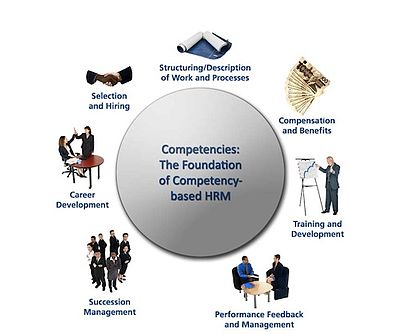- Competency-based management
-
Competency-based human resources planning should serve as a link between human resources management and the overall strategic plan of an organization. Competencies are defined as observable abilities, skills, knowledge, motivations or traits defined in terms of the behaviours needed for successful job performance.
Competency-based management supports the integration of human resources planning with business planning by allowing organizations to assess the current human resource capacity based on their competencies against the capacity needed to achieve the vision, mission and business goals of the organization. Targeted human resource strategies, plans and programs to address gaps (e.g., hiring / staffing; learning; career development; succession management; etc.) are then designed, developed and implemented to close the gaps.
Contents
Purpose
While competencies are not new to most organizations, what is new is their increased application across varied human resource functions (i.e., recruitment/selection; learning and development, performance management, career development and succession planning, human resource planning). Organizations are looking for new ways to acquire, manage and retain the precious talent needed to achieve their business goals.
Properly designed, competencies translate the strategic vision and goals for the organization into behaviours or actions employees must display for the organization to be successful. Competency-based Management (CBM) standardizes and integrates all HR activities based on competencies that support organizational goals.
Connecting CBM to Organizational Execution
CBM solutions typically provide input into and drive all aspects of employee career development. This allows organizations to improve productivity in most areas of human capital management human resources. CBM is typically referred to as "strategic" in that it attempts to link organizational planning to job execution.
- Strategic human resource planning
- Competency architecture
- Competency dictionary
- Competency-based recruitment
- Competency-based learning
- Competency-based performance management
- Competency-based career development
The role of CBM is to shape and guide employee behaviour from "hire to retire". CBM helps Talent acquisition, Performance Management and Learning Management Systems to be more effective by assessing employes skills and competencies. CBM also facilitates gap discovery and suggests learning methods (on the job, literature or formal courses) to help improve employee effectiveness.
Competitive market
The so-called war for talent has driven a marked increase of attention and investment in the talent management space as new vendors continue to enter to support an ever-growing demand for strategic human resources applications. Many of these competitors have entered via the software as a service (SaaS) delivery model, affording small and medium business (SMB) new less-costly options. Competency-based management systems define the job to be down and the consequent required skills to perform said job. The outputs of CBM systems are parameters input into production talent management systems.
Vendors
Vendors of Competency-based Management Systems include:
See also
- Human resource management systems
- Learning management system
- Talent management
References
- Levensaler, Leighanne; Laurano, Madeline (2009), Talent Management Systems 2010, Bersin & Associates, http://www.bersin.com/Lib/Rs/Details.aspx?Docid=103311599
Books
Dubois, D., & Rothwell, W. (2004). Competency-Based Human Resource Management. Davies-Black Publishing
Spencer, L M. in Cherniss, C. and D. Goleman, eds. (2001) “The economic value of emotional intelligence competencies and EIC-based HR programs”, in The Emotionally Intelligent Workplace: How to Select for, Measure, and Improve Emotional Intelligence in Individuals, Groups and Organizations. San Francisco, CA: Jossey-Bass/Wiley
Ulrich, D. and Brockbank, W. (2005) The HR Value Proposition. Boston: Harvard Business School Press
Articles
Bartram, D. (2005) The Great Eight competencies: A criterion-centric approach to validation. Journal of Applied Psychology, 90, 1185–1203
Draganidis, F., & Mentzas, G. (2006). Competency-based management: A review of systems and approaches. Information Management &Computer Security, 14, 51-64
Homer, M. (2001). Skills and competency management. Industrial and Commercial training, 33/2, 59-62
Horton, S. (2000). Introduction- the competency-based movement: Its origins and impact on the public sector. The International Journal of Public Sector Management, 13, 306-318
McEvoy , G., Hayton, J., Wrnick, A., Mumford, T., Hanks, S., & Blahna, M. (2005). A competency-based model for developing human resource professionals. Journal of Management Education, 29, 383- 402
Rausch, E., Sherman, H., & Washbush, J. B. (2002). Defining and assessing competencies for competency-based, outcome-focused management development. The Journal of Management Development, 21, 184-200
Schmidt, F.L., & Hunter, J.E. (1998). The validity and utility of selection methods in personnel psychology: Practice and theoretical implications of research findings. Psychological Bulletin, 124, 262-274
Categories:
Wikimedia Foundation. 2010.

